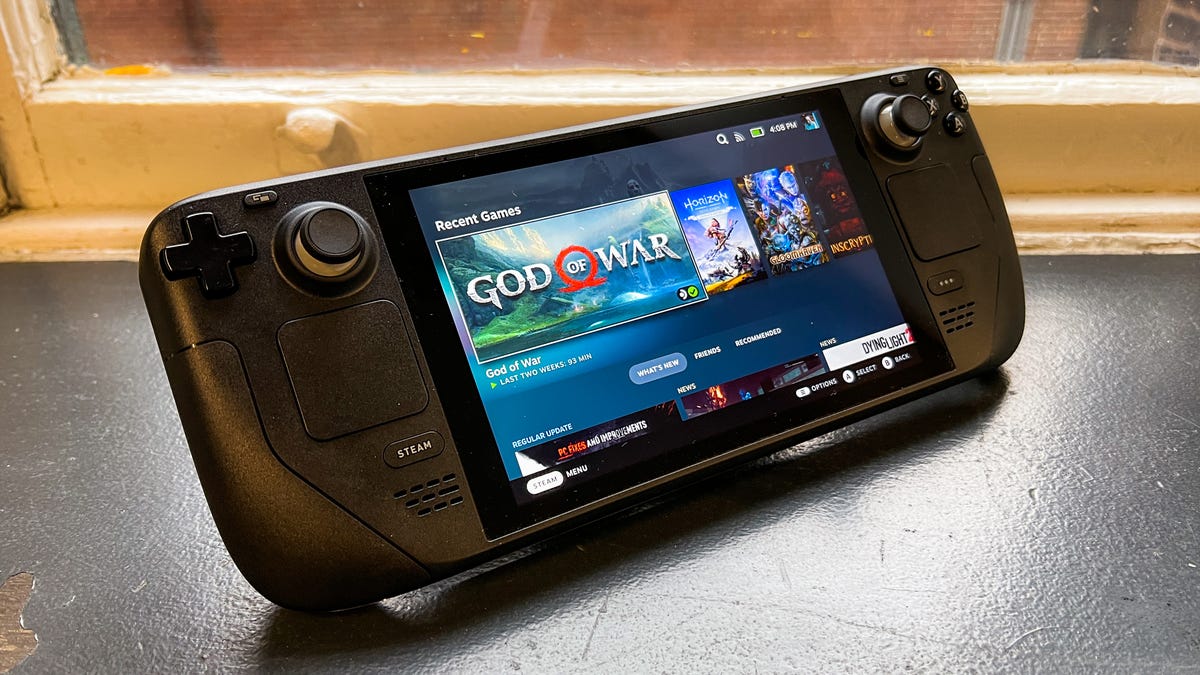Almost everything about the Steam Deck screams first-generation hardware. It’s a little awkward and clunky, sometimes even creaky. The screen has an oversized bezel that makes it feel small within the hulky body. The button layout isn’t especially ergonomic. And especially during its initial months, getting games to play on it sometimes required wrestling the system into submission, using updates, tweaks and hacks to get software running passably.
And yet, after my initial review, I came back to this handheld gaming PC from Valve, time and time again.
Originally, I said it was best for serious PC gamers who were used to the trial-and-error process of getting games to run on different types of computer hardware.
Now, after a year of steady feature updates to its SteamOS software, a series of accessories that fill in some of the hardware gaps and widely increased out-of-the-box support for major game releases, the Steam Deck is a much different animal. I’d say it’s good enough now that even gamers used to the plug-and-play ease of a Nintendo Switch could probably swing it.
Read more: Steam Deck Review: This Handheld Gaming PC Surprised Me, in Ways Both Good and Bad

Dan Ackerman/CNET
Steady evolution
Since its initial release in February last year, the Steam Deck has upgraded or added functionality including better overall performance, smarter cooling and fan speed options, increased compatibility with a massive number of Steam games, better control and sorting of your game library, numerous UI improvements, midgame suspension for quick shutdowns, big improvements to control customization, and better support for expanded microSD storage.
Both Valve and other companies have expanded the Steam Deck’s capabilities through accessories, including docking stations for connecting the system to a TV or monitor and numerous skins, cases and kickstands.
The end result is that the Steam Deck feels like a reasonably polished PC gaming tool now, which is amazing considering it starts at $399 (£349), with two upgraded storage models at $529 and $649. Similar products like the new Razer Edge cost around the same but do less. A lot less.
Making the games the star
The actual hardware, frankly a bit on the underpowered side for a budget gaming PC, isn’t the big selling point. It’s the ability to play PC games, from big new releases to cult indie games, with the convenience of a handheld.
Recently, I’ve been playing Hogwarts Legacy on the Steam Deck, where it runs great (and better than a promised eventual Nintendo Switch version ever will) and Marvel’s Midnight Suns, which took a couple of months to get properly patched for Steam Deck. Games that have worked really well for me include Hard West 2, Uncharted: Legacy of Thieves Collection and Baldur’s Gate 3. Other games that are a natural for Steam Deck include Elden Ring, No Man’s Sky (despite a bug that wiped my saved progress), Vampire Survivors and The Witcher 3.
Valve has gotten better at figuring out which games will work well on the Steam Deck and making that information available to gamers, plus there’s a lot of community suggestions that go beyond the official “great for Steam Deck” tag.
More work to do
That doesn’t mean the Steam Deck is a flawless device. After all, there’s only so much you can do via software updates when the actual hardware is static. Battery life remains an issue — graphically intense games can run for maybe two hours before you need to plug in.
And not all Steam games run, or run well. You’ll often have to drop the graphics settings or compromise on frame rate to make a new game playable. In this area, the Steam Deck’s low screen resolution of 1,280×800 pixels is what allows for a lot of games to play well.
Playing via a TV or monitor through a dock or USB-C-to-HDMI cable isn’t ever going to be great, because often you’ll be playing at higher resolutions than the device can really drive, or else playing at a lower resolution than your 4K screen is capable of. In those cases, an Xbox or PS5 is going to give you a better overall experience.
Getting access to games outside of the Steam ecosystem, including cloud streaming games, remains a hassle — you have to install Microsoft Edge via the Linux-based desktop mode and do a bunch of extra setup from there. Same goes for adding games from other PC gaming storefronts like GOG and the Epic Game Store. Yes, this is a Steam-based product, but PC gamers expect to be able to play games from multiple sources, and they’re right to do so.
The biggest hurdle the Steam Deck faces is that its AMD CPU and GPU aren’t getting any younger, and more powerful components — along with design and ergonomic improvements, a better screen and improved battery life — are on everyone’s must-have list for a Steam Deck 2. There’s no real idea of when that might happen, but the Steam Deck is enough of a hit that a new version is almost guaranteed.
I don’t have any specific insight, but I suspect it’s at least a year or more away. So if you’re interested in buying a Steam Deck for around $500 — I recommend the middle model with 256GB and adding your own microSD card for additional storage — it’s a safe bet to invest now without too much upgrade anxiety.
Valve’s previous hardware initiatives, including the Steam Machine and Steam Controller, never really got out of the gate. With the Steam Deck, the company finally has a genuine hardware hit on its hands. Even better, for me (and I suspect a lot of other people) it has reinvigorated my appreciation for the wide world of PC gaming.

